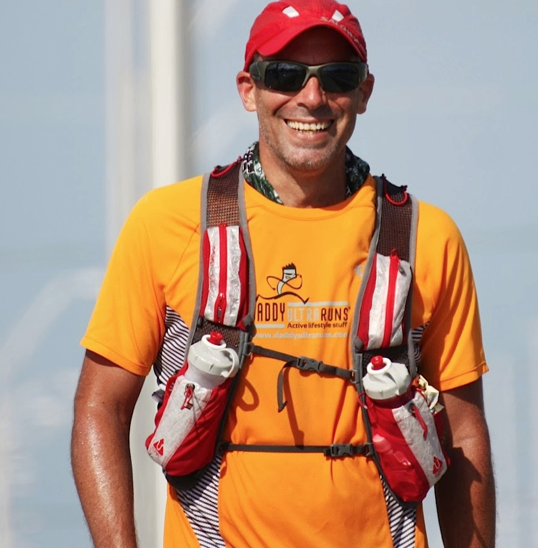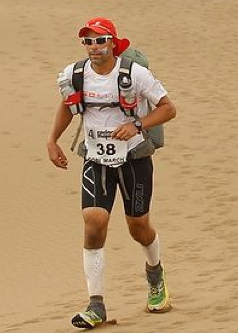 Daddy Ultra Runs is a running specialty store that’s located in Cocoa Village, Florida, heart of the Space Coast. Daddy Ultra Runs is also a member of the Natural Running Center store partner network. DUR’s owner Hernan Garcia is passionate about minimalism when it comes to footwear; and he’s definitely a maximalist when it comes to running long and far, which comes as a surprise since his background is sailing and designing boats.
Daddy Ultra Runs is a running specialty store that’s located in Cocoa Village, Florida, heart of the Space Coast. Daddy Ultra Runs is also a member of the Natural Running Center store partner network. DUR’s owner Hernan Garcia is passionate about minimalism when it comes to footwear; and he’s definitely a maximalist when it comes to running long and far, which comes as a surprise since his background is sailing and designing boats.
“I have been running for years now although my main activity is sailing, which I have done quite extensively around the world,” he says. “I have crossed the Atlantic a couple of times, and sailed the American coastline from the south of Argentina all the way up to Canada, delivering and racing sailboats. Some times as parts of full crews, some times double handed, and a time here and there single handed.”
He’s run over 35 marathons, 20 ultra-marathons and adventure races in remote places such as the Sahara, the Gobi, the Atacama in Chile, Alaska, the Pyrenees, and Patagonia. His toughest race? “I have done is the Susitna 100– a 100-mile race along the Iditarod trail in February in Alaska. For someone coming from Florida, this can be a long trek in frigid weather!”
Hernan has put together the following introductory guide to doing your first ultra. There’s plenty of valuable tips, whether you’re an experienced long-distance runner, or planning to race an ultra as a first-timer. –NRC
Your First Ultra
by Hernan Garcia
***
What is an Ultra?
An Ultra is any running event longer than a marathon (26.2 miles). So, if you ran a race 26.3 miles long, consider yourself an Ultra Marathoner! I would not go around bragging about this as you will get other Ultra Runners upset. There are a number of different types of events that fall in the “Ultra” category, such as 50k’s, 50 milers, 100k’s, 100 milers, multi-day adventure races, 6-, 12-, 24-hour events and on and on! A hard-core Ultra Runner will brag about it only when you run 100 miles non-stop, but no worries.Officially, you will be an ultra runner as long as you keep running to your car after you crossed the finish line of your marathon!
How much do I need to train?
Running for long hours can be very stressful on your body and your family life. We all have different backgrounds (fitness wise) and different goals in mind. I personally run for fun and would like to keep doing it for many years. It is part of my lifestyle and as such, when I train, I need to make sure it fits well within everything else I need to do daily. Hence, my training schedule is typically very moderate (compared to a typical marathon training program). The first step is to “budget” how many hours a week you can allocate to training (be realistic) and then you can lay down a plan. Do you have 10 hours a week to train? Eight? Are all of these going to be spent running? You will be surprised how effective your training can be if you lay down a very realistic goal.
How about my long run?
Don’t you love it when you ask a question and the first sentence in the response is: It depends! Well, It depends! Training (for most of us normal human beings) should be geared to improve our health. That is, we should train at an effort level which allows us to improve our fitness, allowing enough recovery between workout sessions. Long runs for me are an opportunity to be out there doing what I like, so I do it at a very easy pace! If you have a hard time slowing down, I suggest establishing your long run in terms of time and not distance. The long run is your chance to get to learn about your body, its needs, and what to expect as you spend more and more time on your feet! But, if you are going to be part of a race which you expect to take you 12 hours to complete, how long should your training runs be? The trick here is to arrive to race day well rested and well conditioned. A good training program should include a “number” of long runs in the order of 5-6 hours. This type of runs will get you in the habit of eating and drinking while you are running! If your event is expected to take you 24 hours, then your training runs should still be in the order of 5-6 hours but during your training, you might find a race or two in which you can run for 10-12 hours so that you can get a feeling of what to expect!
What kind of energy gels do you eat?
I do not eat any! How about that for an answer! But, we are all different. My issue is: would you be eating gels for 12 hours? How about 24? So don’t expect any one nutrition item will take you through the longer races. Get used to eating as many and as much as you can. Remember, running long should be part of your lifestyle. I do not know many people who jump into their kitchen coverts looking for gels when they have a hunger attack! Do you like eating roasted almonds? How about dry fruit? And a turkey sandwich? These are all great choices for long runs.
What about shoes?
Fitting for a proper shoe is critical, not only for running long distances, but also for day to day activities, 5Ks, walking, training, etc. All feet and different and we all have different mechanics, so there is no such things as one shoe fits all The shoe that might work perfectly for my foot might be pretty bad for you. Having said this, try different options. Different types of running will probably support different type of footwear. Maybe you are running on rocky terrain so you need some protection on the sole, maybe you are running on very hot and muddy terrain so you would like the should to drain quickly, etc. As a general rule of thumb, I always pick the lightest and most flexible shoe that the terrain allows me, with plenty of room in my toe box for my feet to do their job correctly. I want a firm platform that way my nervous system can feel the ground and delivery the proper information to my brain to properly adapt to each footing.
Do I need to wear bigger shoes to allow for swelling of my feet?
Swelling of feet (and hands) is something that normally occurs during long runs. It happens for a number of reasons, one of which (surprising most of you), is improper hydration. Having an improper balance of electrolytes will cause inflammation, so as you probably figured out by now, the key is to get to know your body as you train so that you can anticipate and prevent these situations from happening! In any case, there will always be some inflammation but, I am not a proponent of using shoes that are “bigger”! Shoes should fit right which normally means, at least half an inch of room in front of your longest toe. So, when you get fitted for a shoe, there should be no contact anywhere between your forefoot and the sides and front of the shoe and there should be at least half an inch of room in front of your longest toe of your “longer” foot! For people with wider feet, you could need slightly more than half an inch of room.
 What is the ideal first-time race?
What is the ideal first-time race?
Races come in all shapes and forms. You have trail races, road races, loop races, multi-day self-supported races and on and on! First and foremost, you probably want to, at least in the beginning, stick to a race which takes place in a terrain and weather close to what you will be doing most of your training in. That is, if you live in Alaska and train there, don’t sign up for a 50-miler in the desert as your first event! Also, if you are using the first event as a training run, you might consider doing a “loop race” as these typically have you going back to the same spot on a frequent basis. The advantage of such race is that you can always go back to a place where you have your secret nutrition item or piece of gear which will ensure you continue running. Furthermore, if you are using this type of race as a training run, you can always cut it short once get get back to the “start” without causing too much harm.
How many ultras can you run in a year?
Remember when I said, It depends! Well, here we go again, It depends! Most of us will run at a very comfortable pace without pushing too hard. If this is the case, you are probably not stressing your body too much and will be able to recover very fast. There are many runners who can regularly fit a 100 miler every month, and there are those who can only do one a year. The trick, as it is the case with training, always listen to what your body is telling you as recovery is the most important part of your active lifestyle.
How do I pace myself?
Most people tend to run too fast, Training, racing, always the same case, runners tend to go faster than they should! On a training run, specially if it is your long run, forget the watch and run with people that are typically slower than you! I suggest running with a heart rate monitor and ensuring you are always within your aerobic range, and below your lactate threshold rate. I do not want to get too technical here, just make sure you can chit chat while you are running and you are okay.
What do you think about while running an Ultra?
A lot goes on your mind while you run for so long.The most important thing to consider while running long distances is that you need to make sure you pay attention to what your body is telling you so that you can take care of it. You will be surprised how fast time goes by when you are focused on this aspect. Listen to signals given to you by different parts and systems of your body and do something about it before it becomes a problem. You also have to be able to relax and absorb your surroundings, either the scenery, or a conversation with a fellow runner, or volunteers at check points.There are a lot of positive sources of energy all around you so make sure you have an open mind and attitude as this is critical to get through long days on your feet.
 What kind of gear do I need to carry during my run?
What kind of gear do I need to carry during my run?
In an ideal world, you want to train in such a way that you can be as independent as possible, without relying on outside help.This might mean that you run with a pack, a waist belt, a hand-held bottle, some cash in your pocket, you name it. The more you alter how you run, the more enjoyable all runs become. Races can be different as most have some kind of assistance, but there are many out there that rely on your own capability to carry on by your own means! Some of these events are really nice, so don’t miss out and try to train varying your load as much as possible!
Is it okay to walk during long-distance runs?
Yes! You will have to walk, no matter how strong of a runner you are! Walking is an integral part of your ultra. You will have to walk because the terrain imposes you limitations (hills, river crossings, technical terrain) or because you want to break up your repetitive motions faced during a long flat race. You will also walk right after you leave the aid station with food in your hands! So, it is critical that in your training, you train to walk! This involves other muscles and you want to make sure you can walk at a fast pace. Most novice runners make the mistake of not training how to walk and they only do it when they are tired. This is not the reason for you to walk! You walk to extend your energy and use it to run faster when possible. If you do not train your body to walk fast, then you will be most probably just walking when you are very tired with very poor form…and a recipe for disaster! Sometimes it is very beneficial to carry trekking poles to assist you on your walking. If the race allows the use of trekking poles, you should consider at least training on how to properly use them as they can alleviate a lot of the work to be done by your legs!
***
Contact Hernan here.

